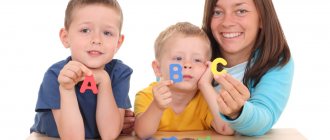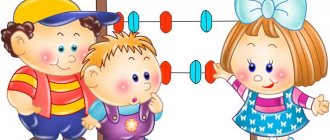Didactic games and aids for speech development of children of senior preschool age
Svetlana Toropova
Didactic games and aids for speech development of children of senior preschool age
Didactic games and aids for speech development of children of senior preschool age
The Federal State Educational Standards requirements for the results of mastering the program are presented in the form of targets for preschool education. At the stage of completing the preschool level, the child must have good command of oral speech, freely express his thoughts and desires, use speech as a means of communication, express his feelings, thoughts, and highlight sounds in words. Speech development of children is very important and relevant in preschool age.
Speech development tasks according to the Federal State Educational Standard:
Mastering speech as a means of communication and culture
enrichment of the active dictionary
development of coherent, dialogic and monologue speech
development of speech creativity
acquaintance with fiction, culture, listening comprehension of various texts, various genres of children's literature
formation of sound analytical-synthetic activity as a prerequisite for learning to read and write
development of sound and intonation culture, phonemic hearing.
To achieve and solve all problems of speech development it is necessary:
creation of a subject-development environment
selection of didactic, developmental, educational games and gaming aids
use of various methods, means, innovative technologies.
personal example of the teacher, his correctly delivered speech
consultations and various forms of work with parents on children’s speech development.
Activating children's speech using a variety of means.
In my work, to activate speech and solve all speech problems, I use the following games and gaming aids:
1. “Loto” using pure phrases for difficult sounds.
Children are offered or children themselves choose their cards, the principle of the game is like an ordinary lotto. The game is complicated by the need to repeat the correct phrase correctly, if the children know how to read, read it. Other reading children can check the correctness of the answer or determine the correctness of the pronunciation. As rewards, you can give not only cards for correct answers, but for example, counting sticks or buttons, pebbles; this is very attractive and energizing for children. If a child experiences difficulty, the teacher needs to help him, because it is difficult the first time, the game requires repetition.
For example: take the picture “Girl with balloons”
The child must repeat or read: “RY-RY-RY, I’M CARRYING BALLS” or For-for-for transparent jellyfish.”
2. “Guess the words”
The cards show two pictures, which may differ from each other when pronounced with the same sound. For example: “Cat” and “Whale”. Children select letters according to the picture, or you can complicate the task - ask a riddle. During the game, the teacher and other participants in the game can come up with riddles and a description of the object themselves. “What picture did I have in mind: this is a fluffy, mustachioed one...” The child guesses and selects the correct letter accordingly.
3. Didactic game “Gifts”
During this game, children develop sound analysis skills, the ability to determine the place of sound in a word.
Children are invited to collect gifts for the boy Roma, but all gifts must have the sound “r”. Children select pictures with a given sound, you can use diagrams, the place of the sound in the word. After the pictures have been selected, you can offer to find these toys in the group and go to visit Roma, then you can develop the role-playing game. There are many game options, fantasize yourself and with your children.
4. Games with punched cards
Punch cards are individual sheets of interesting tasks that are laminated or can be inserted into a thick file for repeated use.
The purpose of each card is different; it can be tasks such as developing phonemic perception, improving the skills of sound-letter analysis, syllabic analysis, reading syllables, composing syllables, words, sentences.
5. "Rebuses"
It’s not difficult to make these cards yourself.
2 strips are glued to the cardboard, one for inserting pictures based on the first sound of which words will be composed, the other below, for inserting letters.
You can use different options:
-which letter is missing (in the middle of the word, at the beginning or end)
- pictures or letters are placed correctly or incorrectly (self-control, mutual control)
- make a diagram
-arrange according to the diagram
6. “Syllable trainer”
Can be used in the role-playing game “School” using the following background:
-help the bear arrange consonants and vowels in the houses
-correct the bear's mistakes
-make up syllables
introduce using the Zhukova simulator to form syllables and words
-identify soft and hard sounds.
Personal trainers
7. Speech snails to reinforce the pronunciation of sounds
I have collected a card index of phonemic nursery rhymes
8. “Syllable Lotto”
The leading activity of preschool children is play; through play, the child learns about the world around him and develops comprehensively. These games contribute to the speech development of children, I hope they will be useful to you too.
Visually - game aid “Speech therapy suitcase”
Visually, the game aid “Speech Therapy Suitcase” is a transformable set of aids that allows you to conduct classes in various areas.
It is made of carpet in the form of a suitcase-album on split rings with filling in the form of a plastic mirror, photos depicting articulation exercises, pictures corresponding to the name of the articulation exercises, letters, numbers, conventional models of sounds, words, prepositions, fairy tale characters and other elements, made of felt on contact tape. Felt has universal properties that allow you to bring almost any idea to life. It is easy to work with, since it does not require special edge processing, pleases with the variety and brightness of the color palette and is pleasant to the touch. Options for games, tasks and exercises using the “Speech Therapy Suitcase” manual (approximate list, since you can come up with endless ideas).
- “Tongue, don’t be lazy, but work hard!”
- "Piano",
- "Palms"
- "Sound House"
- "Make a proposal"
- "Who? What? Signalman",
- "Syllable Engine"
- "Learning to read"
- "Collect the word"
- "Miracle Tree"
- "Whose tail?"
- “Create a non-existent animal”
- “Tell a story”, etc.
What can parents and teachers do?
I was once delighted by Tikheyeva’s idea of raising children based on play. She said the key is to find a compelling story and turn it into a teaching tool. And I took advantage of this. I realized that a personal approach is important here. And what is interesting at 2-3 years old may not affect older people at all. Sometimes, a big book and numerous bright illustrations are all that a baby needs. But for those who are older, the material needs to be informative!
It is worth taking into account the characteristics of toddlers, the foundation of knowledge that is embedded in them, and your goals. You, my good friends, are dealing with the most malleable material. From it you can “blind” whatever you want or whatever you have the strength and courage to do.
For example, raising bilingual children is your conscious choice. You want your child to become fluent in several languages. And you are right, it is much easier to do this at an early age. But then you need to be able to bring the idea to the end, and think about what books to read and what form of education to choose.
But even with knowledge of only one language, development presupposes absolute mutual understanding and interaction between parents and teachers in kindergarten. If they cannot or do not agree to support your work in nurturing your toddler’s personality, you should not trust them with your Miracle!
How to use a lapbook when working with preschoolers
Of course, a lapbook is not just a beautiful craft for decorating a group. This is an invaluable teaching material for speech development. The following areas of its use can be distinguished:
- Lapbook for children. This is a colorful interactive folder that holds secrets. Preschoolers want to look at it and study it again and again in their free time. Unbeknownst to the children themselves, the manual encourages them to develop speech and communicate with peers and adults.
- Lapbook for teachers. This manual allows you to organize a lesson on speech development and provides ready-made material for exercises.
- Lapbook for parents. This is an opportunity to show your creative abilities, spend fun and useful time with your child, organize active communication, and an opportunity to discover the baby’s potential.
Speech development in kindergarten is carried out in a variety of activities and in different forms. A modern approach to organizing this work, in particular the use of a laptop, will make it possible to interest children, systematize their knowledge, and turn learning into an exciting process. It is quite possible to study with such benefits at home.
What teaching aids can you make yourself for kindergarten?
Language development is not an isolated skill. To a large extent, it is determined by the general level of development of the child and, in particular, his intelligence.
Didactic manual on speech development
Activities that improve sensory and fine motor skills in children are of great importance in this process. For this, it is important to use teaching aids, a significant part of which can be made independently.
Children's learning, especially in junior and middle groups, should take place in a playful environment, otherwise they will lose interest in the subject and time will be wasted. For teaching to be effective, the teacher needs to use all available means to maintain the child’s useful activity.
Didactic materials for sensory development
The “Flower Petals” manual looks like this. A circle is attached perpendicularly to the straight stem. The edges of the central part are covered with Velcro. Several petals with images of objects or fairy-tale characters are offered. This fabric is also attached to the inner edge of each of them. The task is to find the petals with the corresponding words based on the letter drawn on the mug and attach them to the central part.
The game “Blow out the insects into the clearing” is designed to develop speech breathing. For this purpose, the “Polyanka” manual is used. It is a low box with high sides. Small cardboards with images of animals are suspended on short threads from the outside. The child must blow them out, but does not have the right to puff out his cheeks.
Important! In this way he is taught how to breathe correctly during a conversation.
The game "Clothespins" is made using the same manual. For this, the kids are given several colored clothespins and asked to build a fence. They place them on the edges, while loudly calling out the color used.
There are two horizontal lines of Velcro glued to the outer wall of the Polyanka manual. Each row contains four cards with images of animals, fairy-tale characters or objects. The child is told that in each row one of the pictures is extra and is asked to remove it. Then he should tell what the remaining images have in common and why.
Lesson with children
Iconic didactic materials
One of these multifunctional aids is “Teremok”. It is a fabric house attached to a flat, solid base. It has a large number of pockets sewn into it, in which various pictures are placed. They can depict objects of the surrounding world, fairy-tale characters from the fairy tale of the same name, images of letters or syllables.
Consultation for parents on the speech development of children 4-5 years old
There are various ways to use this manual in kindergarten.
Here's one of them. Children are shown pictures taken from a pocket attached to the tower. They ask what fairy tale this hero, who is depicted on the card, came from. The child must remember the name of the fairy tale and try to retell its content.
Important! If the child needs the help of a speech therapist, then it is provided. During the story, the teacher asks the child simple leading questions.
You can also use this manual in a preschool educational institution as follows:
- The teacher takes out cards showing the inhabitants of the tower, but does not show them. He depicts the sounds these animals make. The child must repeat them and name the hero of the fairy tale who is depicted on the card.
- The manual can be used to study prepositions that show the relative position of cards. The teacher places cards with pictures of animals in various pockets and asks questions about who is located where. The child must answer using the prepositions “above,” “under,” or “between.”
- Then the child is asked to formulate questions using the mentioned prepositions and ask them to the teacher.
Another task is the following:
- The child is given cards with images of fairy tale characters and asked to place them in various pockets.
- After this, the kid must say which animal lives on which floor and who is to the left, right, above or below him.




